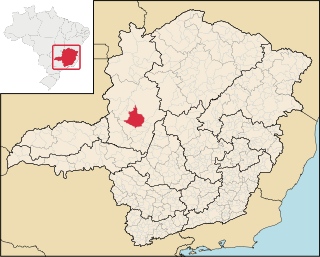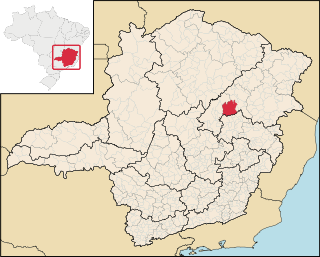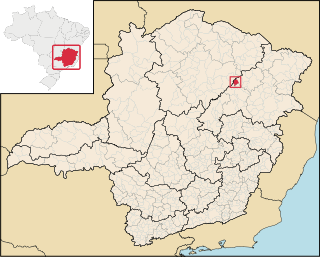
Angelândia is a municipality in the northeast of the Brazilian state of Minas Gerais. As of 2020 the population was 8,557 in a total area of 185 km². The elevation is 891 meters. It is part of the IBGE statistical meso-region of Jequitinhonha and the micro-region of Capelinha. It became a municipality in 1995.

Lyptus is the trade name of a wood made from a hybrid of two species of Eucalyptus tree, Eucalyptus grandis and Eucalyptus urophylla. Developed for quick harvesting, and grown on plantations in Brazil, Lyptus is marketed as an environmentally friendly alternative to oak, cherry, mahogany, and other wood products that may be harvested from old growth forests. Lyptus trees can be harvested for lumber in approximately 15 years, much sooner than woods from cooler climates.

Curvelo is a municipality in the state of Minas Gerais, Brazil. It is located in the geodesic centre of Minas Gerais, 170 km north of the capital, Belo Horizonte, and connected to the capital by highways MG 135 and BR 040. Its estimated population is 80,616 inhabitants (2020) and the total area of the municipality is 3,344 kmª. The city lies at an altitude of 633 metres.

Capelinha is a Brazilian municipality located in the north-center of the state of Minas Gerais. Its population as of 2020 was 38,057 living in a total area of 966 km². The city belongs to the statistical mesoregion of Jequitinhonha and to the statistical microregion of Capelinha. It became a municipality in 1913.

Morro da Garça is a Brazilian municipality located in the northeast of the state of Minas Gerais. Its population as of 2020 was 2,437 living in a total area of 414 km2. The city belongs to the statistical mesoregion of Central Mineira and to the statistical microregion of Curvelo. It became a municipality in 1962.

For the municipality in Maranhão see Presidente Juscelino, Maranhão

Botumirim is a Brazilian municipality located in the north of the state of Minas Gerais. In 2020 the population was 6,288 in a total area of 1,572 km2. The elevation is 948 meters. It became a municipality in 1962.

Cristália is a Brazilian municipality located in the north of the state of Minas Gerais. In 2020 the population was 5,982 in a total area of 841 km2. The elevation is 728 meters. It became a municipality in 1962.

Presidente Olegário is a municipality in the north of the Brazilian state of Minas Gerais. Its population in 2020 was 19,627 inhabitants in a total area of 3,531 km2 (1,363 sq mi).

Varjão de Minas is a municipality in the north of the Brazilian state of Minas Gerais. Its population in 2020 was 7,138 inhabitants in a total area of 653 km2.

Berilo is a municipality in the northeast of the Brazilian state of Minas Gerais. As of 2020 the population was 11,872 in a total area of 586 km2. The elevation is 401 meters. It is part of the IBGE statistical meso-region of Jequitinhonha and the micro-region of Capelinha. It became a municipality in 1963.

Itamarandiba is a Brazilian municipality located in the north-center of the state of Minas Gerais. Its population as of 2020 was 34,936 living in a total area of 2,736 km².

Jenipapo de Minas is a municipality in the northeast of the Brazilian state of Minas Gerais. As of 2020 the population was 7,738 in a total area of 284 km². The elevation of the town center is 521 meters. It is part of the IBGE statistical meso-region of Jequitinhonha and the micro-region of Capelinha. It became a municipality in 1997.

José Gonçalves de Minas is a municipality in the northeast of the Brazilian state of Minas Gerais. As of 2020 the population was 4,487 in a total area of 382 km². The elevation of the town center is 546 meters. It is part of the IBGE statistical meso-region of Jequitinhonha and the micro-region of Capelinha. It became a municipality in 1997.

Leme do Prado is a municipality in the northeast of the Brazilian state of Minas Gerais. As of 2020 the population was 4,920 in a total area of 281 square kilometres (108 sq mi)

Minas Novas is a municipality in the northeast of the Brazilian state of Minas Gerais. In 2020, the population was 31,497 in a total area of 1,810 km². The elevation of the urban area is 635 meters. It is part of the IBGE statistical meso-region of Jequitinhonha and the micro-region of Capelinha. It became a municipality in 1730.

Turmalina is a municipality in the northeast of the Brazilian state of Minas Gerais. As of 2020 the population was 20,125 in a total area of 1,153 km². The elevation of the urban area is 718 meters. It is part of the IBGE statistical meso-region of Jequitinhonha and the micro-region of Capelinha. It became a municipality in 1949.

Veredinha is a municipality in the northeast of the Brazilian state of Minas Gerais. As of 2020 the population was 5,727 in a total area of 635 km². The elevation of the urban area is 635 meters. It is part of the IBGE statistical meso-region of Jequitinhonha and the micro-region of Capelinha. It became a municipality in 1995.

Eucalyptus urophylla, commonly known as Timor white gum, Timor mountain gum, popo or ampupu, is a species of eucalypt native to islands of the Indonesian Archipelago and Timor.
Timocratica palpalis is a moth of the family Depressariidae. It is found in Brazil, Bolivia and Argentina.


















